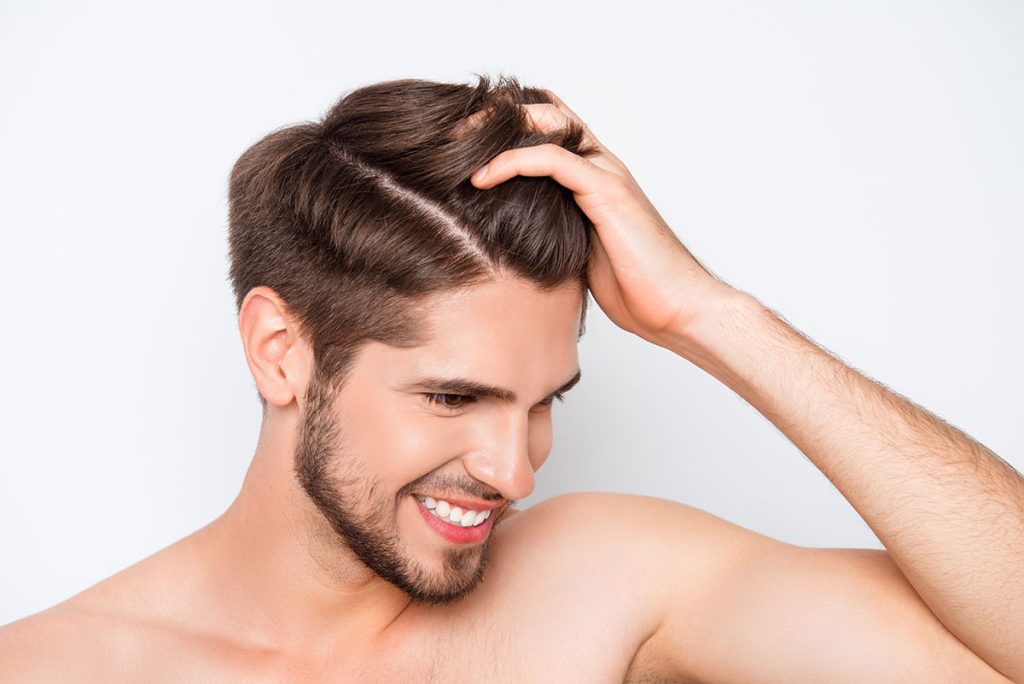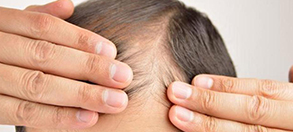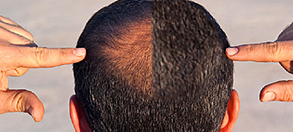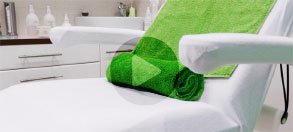For better or worse, there are as many innovations promising hair loss reversal as there are people experiencing hair loss. Our goal at Houston Hair Transplant Center is to educate our patients to make informed decisions about how to approach hair restoration. Hair loss can affect confidence and the ability to enjoy life because of the importance society places on appearance, and the association between hair, youth, and beauty. It’s no surprise so many people reach out to Dr. Goran Jezic, MD, for help.
Laser hair caps use low-level laser (light) therapy (LLLT) to reinvigorate hair growth. These systems are non-ablative meaning they do not remove skin; these are not the intense lasers you might find with other cosmetic procedures. But with so many differing efficacy claims out there, patients are left wondering if they are wasting their money. Here we discuss what LLLT is and how effective it is in treating patterned hair loss.
Interested in learning more about our practice and how we have helped countless patients in the Houston area discover personalized hair treatment solutions? Follow our blog, or set up a consultation with Dr. Jezic by calling (713) 864-2300. You can also fill out our contact form, and we will get back to you shortly.
What Causes Hair Loss?
An estimated 50% of the male population over 40 suffers from male-pattern baldness, also called androgenetic alopecia (AGA). [1] However, many women also suffer from hair loss; only around 45% of women go through life without experiencing significant hair loss. [2] Over 75% of females experience AGA over 65. AGA is believed to be connected to inflammation, which can damage cells in the scalp. Hair loss can be a result of genetics, changes in hormone levels, aging, disease, or trauma. Women often find the continued use of extensions or other hair styling methods may lead to thinning hair. In men, hair loss is most associated with DHT (dihydrotestosterone) hormone levels. Additionally, the pattern in which hair loss evolves looks different for men and women.
Female Hair Loss Patterns
The most commonly used classification system to quantify hair loss in women was presented by Dr. Erich Ludwig in 1977. [3] His proposed classification system consists of three grades of hair loss:
- Grade I: visibly thinning hair on the crown of the head, 1-3 cm behind the frontal hairline
- Grade II: more pronounced hair loss on the crown
- Grade III: total baldness within the areas seen in grades I and II
With most patients responding to anti-androgen treatment, scientists assume that female pattern baldness is an androgen-dependent condition. [2] Androgens are hormones that contribute to growth and reproduction, and while they are more prevalent in the male body, women produce a small amount as well, around one-tenth to one-twentieth the amount produced by men.
Male Hair Loss Patterns
Male pattern baldness, or hair follicle miniaturization, causes hair follicles to constrict, impeding hair growth and eventually keeping them from producing any hair. In 1951, William James Hamilton described his system for grading male-pattern baldness. [3] The Hamilton classifications are as follows:
- Type I: No sign of hair loss
- Type II: A slight recession of the hairline around the temples
- Type III: The hairline appears deep-set at the temples in an M, U, or V pattern.
- Type III vertex: The hairline appears the same as in type II but with added hair loss on top of the scalp (the vertex).
- Type IV: A more severe recession at the hairline than in type II, with sparse or no hair on the vertex; a band of hair separates the bald areas.
- Type V: The band of hair becomes narrower than in type IV, and the hair is thin.
- Type VI: The balding areas at the temples join the vertex. The band of hair is gone.
- Type VII: The most severe stage of hair loss. A small band of hair grows around the sides of the head.
Patterned baldness is a chronic condition that requires consistent application of Treatment to produce a visible change. Could low-level laser (light) therapy (LLLT) offer that change?
What is Low-Level Light Therapy?
The discovery that low-level laser therapy (LLLT) grows hair faster than without treatment was first presented in 1967 when Hungarian physician Endre Mester treated mice with lasers to discover possible destructive effects. Instead, Mester noticed that hair in shaved areas on the mice grew significantly faster than in areas on mice who were not exposed. [4] He also noted that there were no carcinogenic changes. [5]
Thus, low-level light therapy has also been demonstrated effective in promoting hair growth in males and females. For example, a study designed to investigate at-home LLLT systems demonstrated that constant illumination over the areas of the scalp covered by a laser hair cap showed a 37% increase in hair growth in males and a similar increase in females. [4] Treatment was carried out over 16 weeks, in 25-minute sessions every other day. The active treatment group used a cap containing 21 laser diodes and 30 LEDs operating at 655 nanometers of light per diode.
The Laser Cap offered by the Houston Hair Transplant Center consists of approx. 300 diodes and is the most powerful in the market. It can be used at home while watching TV or listening to music or while talking on your cell phone. It takes merely 20 minutes per day and you own it forever. The price is very affordable and its even lower if you undergo a hair transplant and/or PRP series with Dr. Jezic.
Phototherapy treatment for hair growth using LLLT meets the requirements of FDA non-medical laser standards, meaning the FDA has granted clearance for devices treating pattern baldness. LLLT has anti-inflammatory properties and is thought to increase cell production as well. [4]
It is important to note that the FDA granted clearance for these devices regarding male hair loss up to type V, female grades I & II, and those patients with light to moderate skin tones. Furthermore, the efficacy of LLLT on darker skin tones and progressive hair loss has not been demonstrated.
NASA Helps Regrow Hair!
Believe it or not, NASA had a hand in creating the Light-Emitting Diodes (LED), which we now see in many biomodulating treatments. In 1998, Professor Harry Whelan and his group at the NASA Space Medicine Laboratory developed a phototherapy source that was more effective than previous laser treatment. Thus ending the criticism, “They can put a man on the moon, but they can’t regrow my hair!”
The NASA diodes offered less divergence, higher and more stable output powers, and increased consistency with photon wavelengths. Because of these changes, phototherapy could produce useful bioreactions without heat or damage, and the term “low-level laser therapy” was changed to low-level light therapy. [5]
Additional Applications of Phototherapy Treatment
As phototherapy treatment becomes more widely accepted, the many applications increase, including:
- Pain relief: LED phototherapy significantly decreases acute and chronic pain in athletes.
- Nerve regeneration: LED phototherapy treatment is used in spinal cord injuries.
- Dental implants and prostheses: LED phototherapy is used for guided bone regeneration.
- Dermatology: LED phototherapy is used for wound healing and skin damage due to increased fibroblast production.
- Hair Regeneration: The new generation of LED phototherapy at 830 nm is effective in hair growth regeneration.[5]
- One of our staff members underwent laser hair therapy which reduced his dependence on topical steroids for his autoimmune scalp condition and appeared to strengthen his hair.
Is Laser Hair Cap Therapy Right for You?
It’s important to remember that phototherapy treatment only effectively stimulates growth in the hair you already have — Dr. Jezic offers many effective treatments for restoring areas with complete hair loss. As a hair transplant surgeon and restoration specialist, Dr. Jezic’s skill and focus give his patients the upper hand.
Follicular Unit Extraction (FUE)
FUE is Dr. Jezic and Houston Hair Transplant Center’s specialty. Instead of hair plugs, FUE grafts a few individual hair follicles at a time, producing a more natural result and reduced downtime for recovery. Patients love this minimally invasive procedure that restores dignity and confidence compromised by hair loss.
Finasteride (Propecia)
For our male patients who choose at-home laser hair cap treatment, you can increase your results by including a hair loss solution like finasteride. Finasteride works by reducing an enzyme that increases the byproduct of testosterone thought to contribute to male-pattern baldness.
Minoxidil (Rogaine)
An option for our female patients (who should not use finasteride) is minoxidil treatment. This topical treatment increases blood flow, which is thought to increase hair growth.
To speak with Dr. Jezic in person about these or other hair loss solutions, call our dedicated staff at (713) 864-2300, so we can assist you in setting up a consultation.
FAQ
Does Low Level Laser (Light) Therapy Hurt?
LLLT is a painless therapy because the output levels are not intense enough to produce a burn, nor is there enough heat produced to cause discomfort.
What if I Have Significant Hair Loss?
LLLT is not effective for advanced hair loss. It is meant to strengthen and stimulate hair follicles, and provide the appearance of thicker hair. Those experiencing significant balding should schedule a consultation with Dr. Jezic to discuss treatment options.
References
- Jimenez JJ, Wikramanayake TC, Bergfeld W, et al. Efficacy and Safety of a Low-level Laser Device in the Treatment of Male and Female Pattern Hair Loss: A Multicenter, Randomized, Sham Device-controlled, Double-blind Study. American Journal of Clinical Dermatology. 2014;15(2):115-127. doi:10.1007/s40257-013-0060-6
- Dinh QQ, Sinclair R. Female pattern hair loss: current treatment concepts. Clinical interventions in aging. 2007;2(2):189-199. https://www.ncbi.nlm.nih.gov/pmc/articles/PMC2684510/
- Gupta M, Mysore V. Classifications of patterned hair loss: a review. Journal of Cutaneous and Aesthetic Surgery. 2016;9(1):3. doi:10.4103/0974-2077.178536
- Lanzafame RJ, Blanche RR, Chiacchierini RP, Kazmirek ER, Sklar JA. The growth of human scalp hair in females using visible red light laser and LED sources. Lasers in Surgery and Medicine. 2014;46(8):601-607. doi:10.1002/lsm.22277
- Kim WS, Calderhead RG. IS LIGHT-EMITTING DIODE PHOTOTHERAPY (LED-LLLT) REALLY EFFECTIVE? LASER THERAPY. 2011;20(3):205-215. doi:10.5978/islsm.20.205



